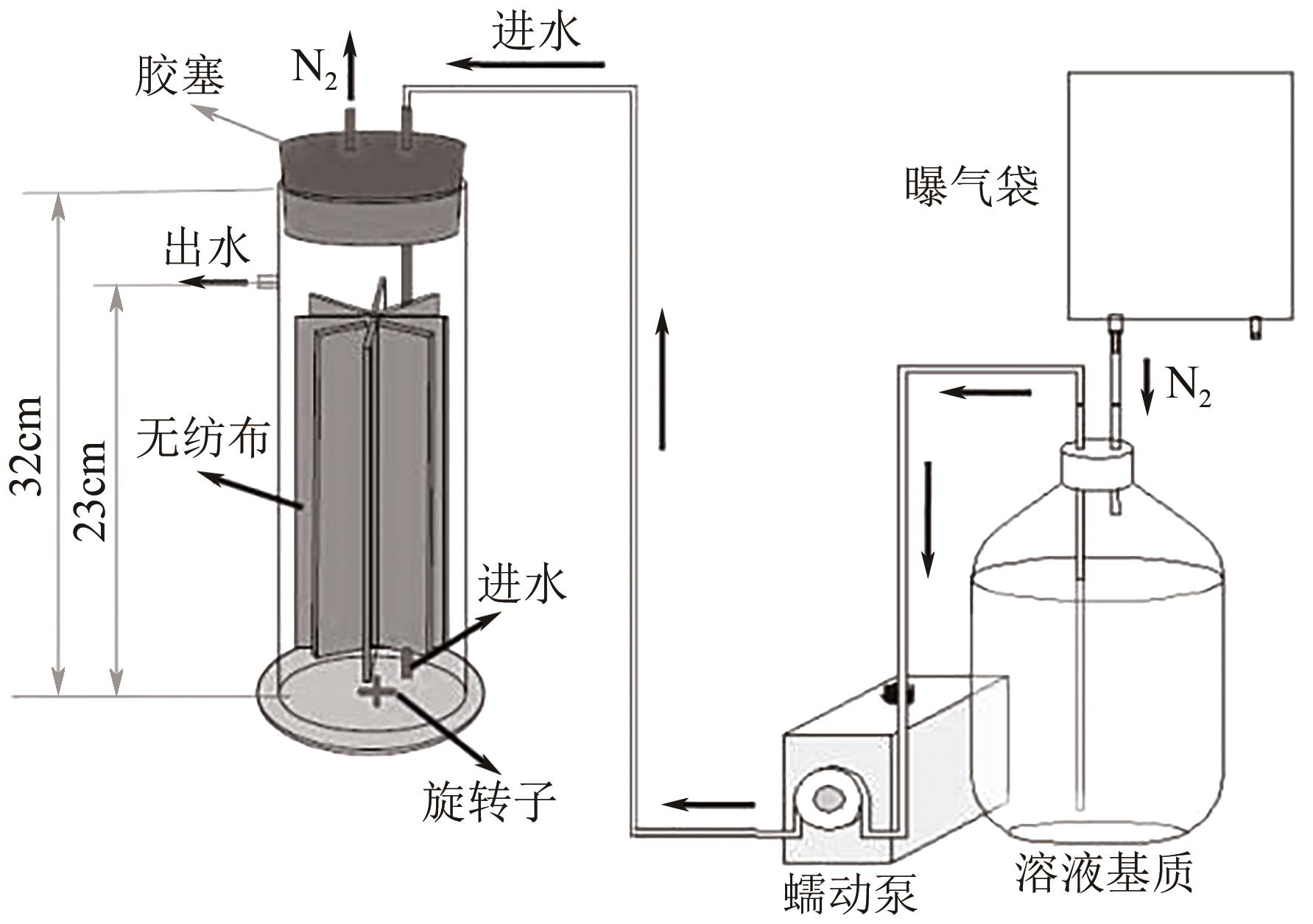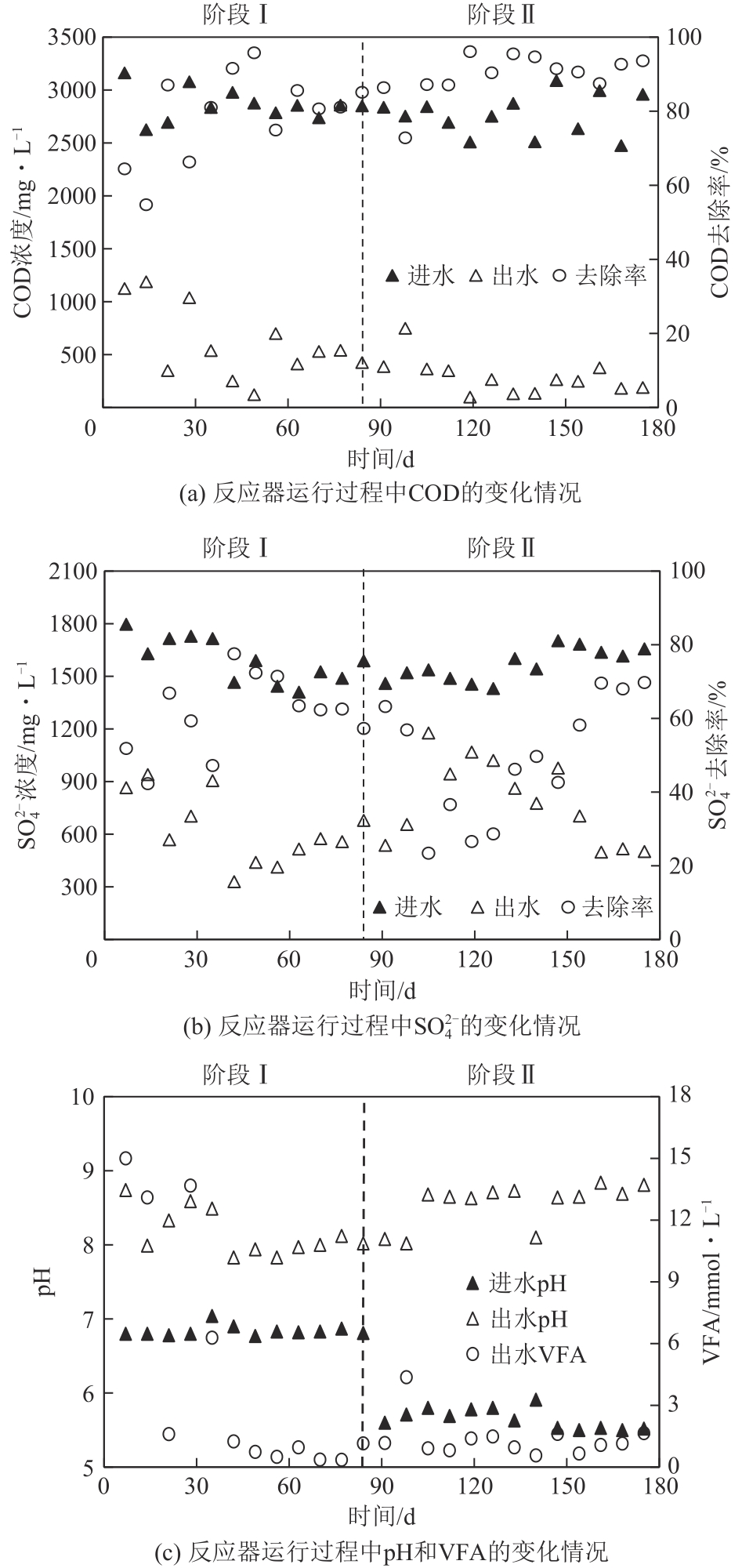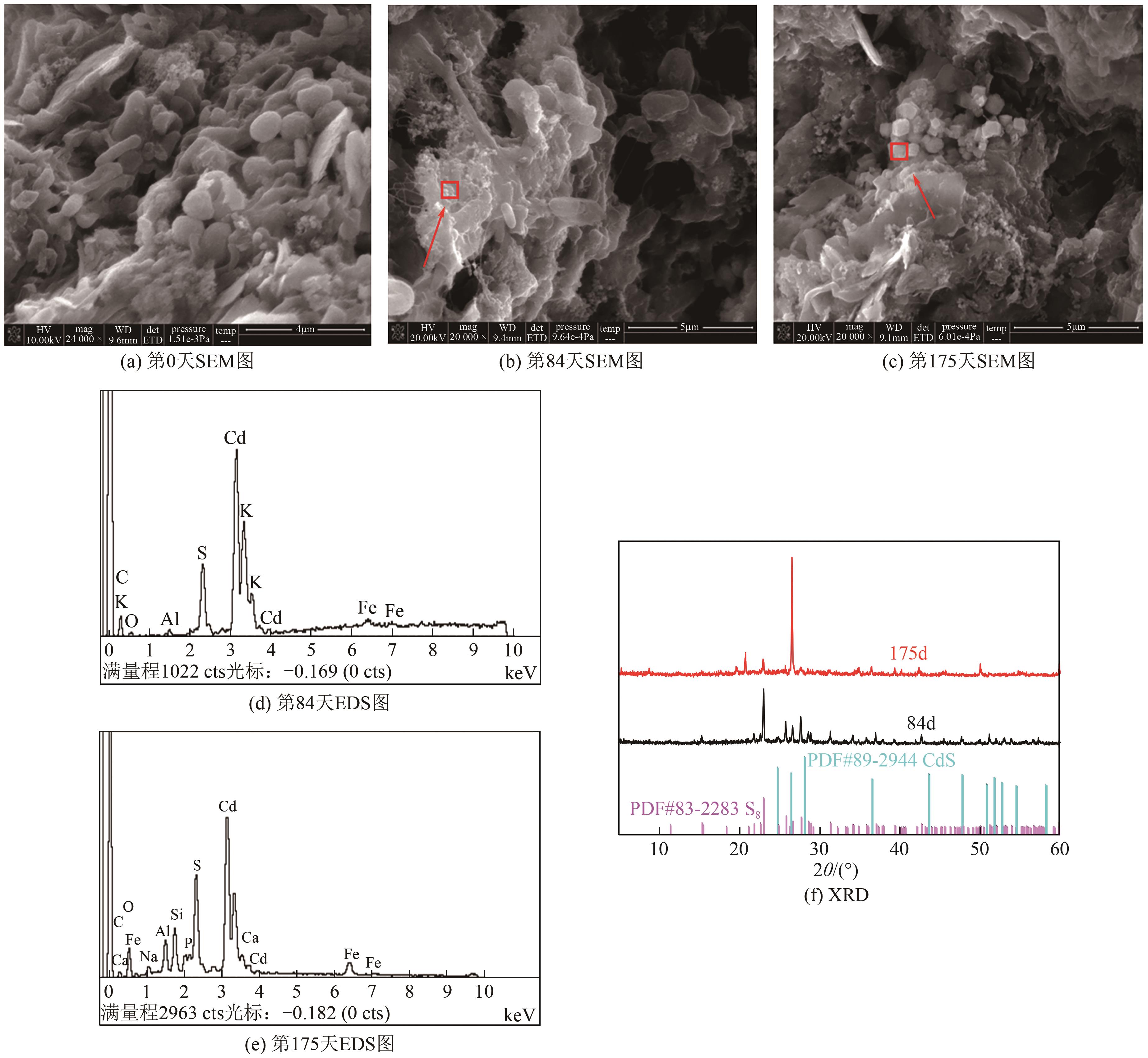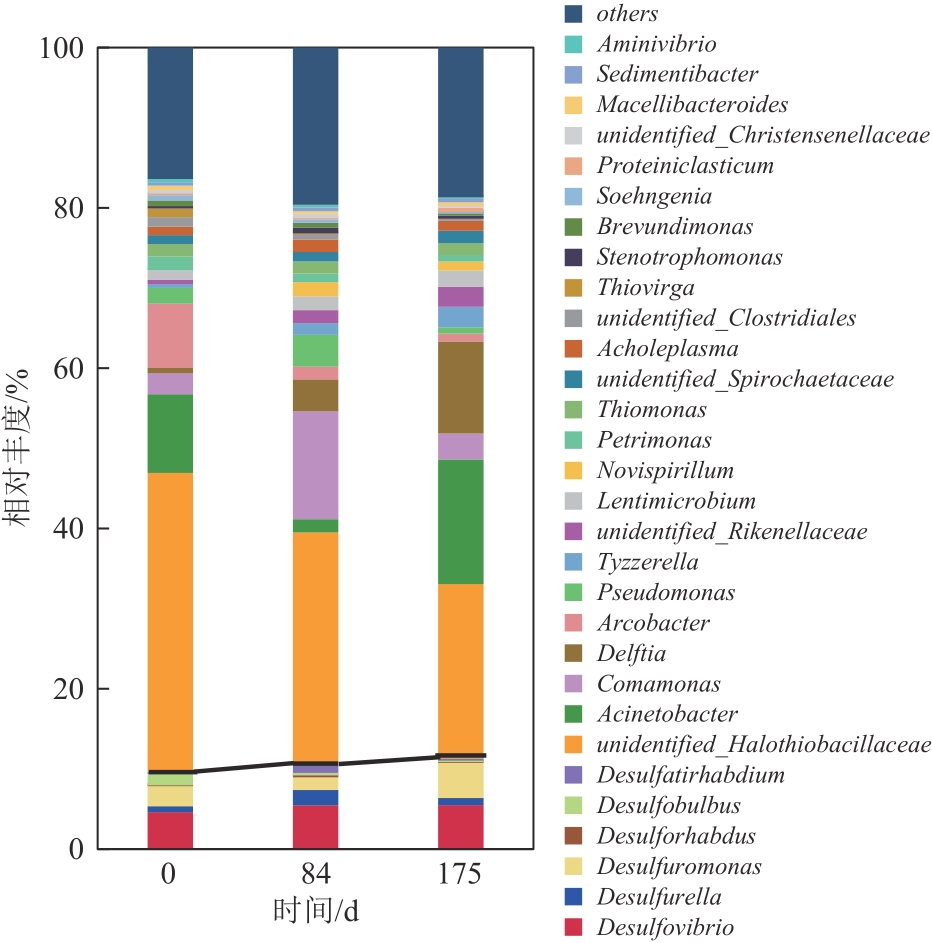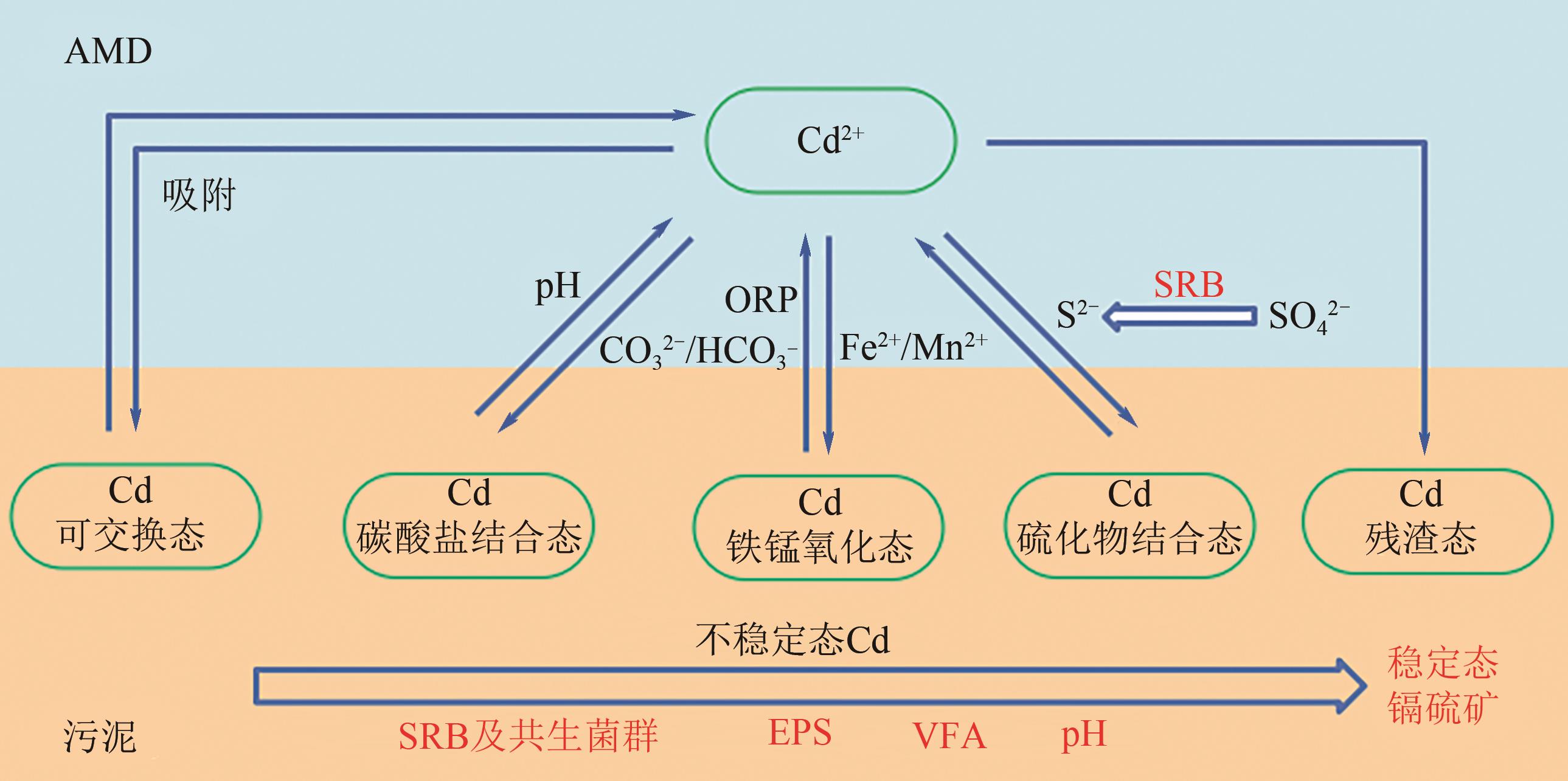化工进展 ›› 2023, Vol. 42 ›› Issue (10): 5509-5519.DOI: 10.16085/j.issn.1000-6613.2022-2222
硫酸盐还原活性污泥矿化固定酸性矿山废水中的镉
王大为( ), 毕春梦, 秦永丽(
), 毕春梦, 秦永丽( ), 蒋永荣, 谢华宾, 毛宇昆, 苗雪岩
), 蒋永荣, 谢华宾, 毛宇昆, 苗雪岩
- 桂林电子科技大学生命与环境科学学院,广西 桂林 541004
-
收稿日期:2022-12-01修回日期:2023-02-01出版日期:2023-10-15发布日期:2023-11-11 -
通讯作者:秦永丽 -
作者简介:王大为(2000—),男,本科生,研究方向为污水生物处理及微生物学。E-mail:1483703243@qq.com。 -
基金资助:国家自然科学基金(52060004);广西自然科学基金(2023GXNSFBA026265);广西高校中青年教师科研基础能力提升(2021KY0204);国家级大学生创新训练(202110595063);广西区大学生创新训练(202010595164)
Sulfate-reducing activated sludge for immobilization of cadmium in acid mine drainage by mineralization
WANG Dawei( ), BI Chunmeng, QIN Yongli(
), BI Chunmeng, QIN Yongli( ), JIANG Yongrong, XIE Huabin, MAO Yukun, MIAO Xueyan
), JIANG Yongrong, XIE Huabin, MAO Yukun, MIAO Xueyan
- School of Life and Environmental Sciences, Guilin University of Electronic Technology, Guilin 541004, Guangxi, China
-
Received:2022-12-01Revised:2023-02-01Online:2023-10-15Published:2023-11-11 -
Contact:QIN Yongli
摘要:
为了实现硫酸盐生物还原法处理酸性矿山废水(AMD)中镉(Cd)的稳定去除,受自然界硫酸盐还原菌诱导的生物矿化现象启发,以驯化的硫酸盐还原活性污泥为种泥,在上流式厌氧反应器内,通过维持进水浓度比COD/SO
中图分类号:
引用本文
王大为, 毕春梦, 秦永丽, 蒋永荣, 谢华宾, 毛宇昆, 苗雪岩. 硫酸盐还原活性污泥矿化固定酸性矿山废水中的镉[J]. 化工进展, 2023, 42(10): 5509-5519.
WANG Dawei, BI Chunmeng, QIN Yongli, JIANG Yongrong, XIE Huabin, MAO Yukun, MIAO Xueyan. Sulfate-reducing activated sludge for immobilization of cadmium in acid mine drainage by mineralization[J]. Chemical Industry and Engineering Progress, 2023, 42(10): 5509-5519.
| 阶段 | 运行时间/d | 进水COD浓度/mg·L-1 | 进水SO42-浓度/mg·L-1 | 进水Cd2+浓度/mg·L-1 | 进水pH | HRT/h |
|---|---|---|---|---|---|---|
| Ⅰ | 1~84 | 3000 | 1500 | 80 | 6.5 ± 0.2 | 72 |
| Ⅱ | 85~175 | 3000 | 1500 | 100 | 5.5 ± 0.2 | 72 |
表1 反应器运行操作参数
| 阶段 | 运行时间/d | 进水COD浓度/mg·L-1 | 进水SO42-浓度/mg·L-1 | 进水Cd2+浓度/mg·L-1 | 进水pH | HRT/h |
|---|---|---|---|---|---|---|
| Ⅰ | 1~84 | 3000 | 1500 | 80 | 6.5 ± 0.2 | 72 |
| Ⅱ | 85~175 | 3000 | 1500 | 100 | 5.5 ± 0.2 | 72 |
| 1 | 倪师军, 李珊, 李泽琴, 等. 矿山酸性废水的环境影响及防治研究进展[J]. 地球科学进展, 2008, 23(5): 501-508. |
| NI Shijun, LI Shan, LI Zeqin, et al. Progress in the research of acid mine drainage impact and remediation[J]. Advances in Earth Science, 2008, 23(5): 501-508. | |
| 2 | 闻倩敏, 秦永丽, 郑君健, 等. 硫酸盐还原菌法固定酸性矿山废水中重金属的研究进展[J]. 化工进展, 2022, 41(10): 5578-5587. |
| WEN Qianmin, QIN Yongli, ZHENG Junjian, et al. Research advances in the fixation of heavy metals in acid mine wastewater by sulfate reducing bacteria[J]. Chemical Industry and Engineering Progress, 2022, 41(10): 5578-5587. | |
| 3 | JEAN M. Continuous pilot scale assessment of the alkaline barium calcium desalination process for acid mine drainage treatment[J]. Journal of Environmental Chemical Engineering, 2015, 3(2): 1295-1302. |
| 4 | LIAO Jianbo, WEN Zewei, RU Xuan, et al. Distribution and migration of heavy metals in soil and crops affected by acid mine drainage: Public health implications in Guangdong Province, China[J]. Ecotoxicology and Environmental Safety, 2016, 124: 460-469. |
| 5 | JIANG Yongrong, ZHANG Jie, WEN Qianmin, et al. Up-flow anaerobic column reactor for sulfate-rich cadmium-bearing wastewater purification: System performance, removal mechanism and microbial community structure[J]. Biodegradation, 2022, 33(3): 239-253. |
| 6 | JAYASHREE J, NILOTPALA P, AISHVARYA V, et al. Biological sequestration and retention of cadmium as CdS nanoparticles by the microalga Scenedesmus-24[J]. Journal of Applied Phycology, 2015, 27(6): 2251-2260. |
| 7 | KURNIAWAN T A, CHAN G Y S, LO W H, et al. Comparisons of low-cost adsorbents for treating wastewaters laden with heavy metals[J]. Science of the Total Environment, 2006, 366(2/3): 409-426. |
| 8 | XU Yanan, CHEN Yinguang. Advances in heavy metal removal by sulfate-reducing bacteria[J]. Water Science and Technology, 2020, 81(9): 1797-1827. |
| 9 | LI Xin, WU Youe, ZHANG Chang, et al. Immobilizing of heavy metals in sediments contaminated by nonferrous metals smelting plant sewage with sulfate reducing bacteria and micro zero valent iron[J]. Chemical Engineering Journal, 2016, 306: 393-400. |
| 10 | DEL BUSSO ZAMPIERI B, ELIS W N, DE OLIVEIRA A J F C, et al. Effects of metals on activity and community of sulfate-reducing bacterial enrichments and the discovery of a new heavy metal-resistant SRB from Santos Port sediment (São Paulo, Brazil)[J]. Environmental Science and Pollution Research, 2022, 29(1): 922-935. |
| 11 | KIM S D, KILBANE J J II, CHA D K. Prevention of acid mine drainage by sulfate reducing bacteria: Organic substrate addition to mine waste piles[J]. Environmental Engineering Science, 1999, 16(2): 139-145. |
| 12 | SAMPAIO G F, DOS SANTOS A M, COSTA P R DA, et al. High rate of biological removal of sulfate, organic matter, and metals in UASB reactor to treat synthetic acid mine drainage and cheese whey wastewater as carbon source[J]. Water Environment Research, 2020, 92(2): 245-254. |
| 13 | ŇANCUCHEO I, JOHNSON D B. Selective removal of transition metals from acidic mine waters by novel consortia of acidophilic sulfidogenic bacteria[J]. Microbial Biotechnology, 2012, 5(1): 34-44. |
| 14 | ZHANG Hongguo, LI Huosheng, LI Meng, et al. Immobilizing metal-resistant sulfate-reducing bacteria for cadmium removalfrom aqueous solutions[J]. Polish Journal of Environmental Studies, 2018, 27(6): 2851-2859. |
| 15 | PENG Weihua, LI Xiaomin, LIU Tong, et al. Biostabilization of cadmium contaminated sediments using indigenous sulfate reducing bacteria: Efficiency and process[J]. Chemosphere, 2018, 201: 697-707. |
| 16 | MOKONE T P, VAN HILLE R P, LEWIS A E. Metal sulphides from wastewater: Assessing the impact of supersaturation control strategies[J]. Water Research, 2012, 46(7): 2088-2100. |
| 17 | 崔福斋. 生物矿化[M]. 北京: 清华大学出版社, 2007. |
| CUI Fuzhai. Biomineralization[M]. Beijing: Tsinghua University Press, 2007. | |
| 18 | LABRENZ M, DRUSCHEL G K, THOMSEN-EBERT T, et al. Formation of sphalerite (ZnS) deposits in natural biofilms of sulfate-reducing bacteria[J]. Science, 2000, 290(5497): 1744-1747. |
| 19 | EDWARDS K J, HU B, HAMERS R J, et al. A new look at microbial leaching patterns on sulfide minerals[J]. FEMS Microbiology Ecology, 2001, 34(3): 197-206. |
| 20 | ZHANG H Z, BANFIELD J F. Aggregation, coarsening, and phase transformation in ZnS nanoparticles studied by molecular dynamics simulations[J]. Nano Letters, 2004, 4(4): 713-718. |
| 21 | GARCÍA C, MORENO D A, BALLESTER A, et al. Bioremediation of an industrial acid mine water by metal-tolerant sulphate-reducing bacteria[J]. Minerals Engineering, 2001, 14(9): 997-1008. |
| 22 | 刘牡丹, 刘勇, 陈志强, 等. 添加剂对工业重金属污泥矿化过程微观粒度的影响[J]. 有色金属(冶炼部分), 2019(7): 11-16. |
| LIU Mudan, LIU Yong, CHEN Zhiqiang, et al. Effect of additives on micro particle size of industrial heavy metal sludge in mineralization process[J]. Nonferrous Metals (Extractive Metallurgy), 2019(7): 11-16. | |
| 23 | LIN Q, WANG J S, ALGEO T J, et al. Enhanced framboidal pyrite formation related to anaerobic oxidation of methane in the sulfate-methane transition zone of the northern South China Sea[J]. Marine Geology, 2016, 379: 100-108. |
| 24 | 郑婉盈, 张色, 吴明林, 等. 耐镉硫酸盐还原活性污泥的驯化及其微生物群落结构分析[J]. 环境污染与防治, 2021, 43(1): 47-51. |
| ZHENG Wanying, ZHANG Se, WU Minglin, et al. The domestication of cadmium-resistant sulfate reducing activated sludge and analysis of its microbial community structure[J]. Environmental Pollution & Control, 2021, 43(1): 47-51. | |
| 25 | JIANG Yongrong, LI Hua, QIN Yongli, et al. Spatial separation and bio-chain cooperation between sulfidogenesis and methanogenesis in an anaerobic baffled reactor with sucrose as the carbon source[J]. International Biodeterioration & Biodegradation, 2019, 138: 99-105. |
| 26 | 国家环境保护总局, 水和废水监测分析方法编委会. 水和废水监测分析方法[M]. 4版. 北京: 中国环境科学出版社, 2002. |
| State Environmental Protection Administration, Editorial Committee of Water and Wastewater Monitoring and Analysis Methods. Monitoring and analysis methods of water and wastewater [M]. 4th ed. Beijing: China Environmental Science Press, 2002. | |
| 27 | ALBORÉS A F, CID B P, GÓMEZ E F, et al. Comparison between sequential extraction procedures and single extractions for metal partitioning in sewage sludge samples[J]. Analyst, 2000, 125(7): 1353-1357. |
| 28 | KUSHKEVYCH I, DORDEVIĆ D, VÍTĚZOVÁ M. Toxicity of hydrogen sulfide toward sulfate-reducing bacteria Desulfovibrio piger Vib-7[J].Archives of Microbiology, 2019, 201(3): 389-397. |
| 29 | ZAGURY G J, KULNIEKS V I, NECULITA C M. Characterization and reactivity assessment of organic substrates for sulphate-reducing bacteria in acid mine drainage treatment[J]. Chemosphere, 2006, 64(6): 944-954. |
| 30 | JOHNSON D B, HALLBERG K B. Biogeochemistry of the compost bioreactor components of a composite acid mine drainage passive remediation system[J]. Science of the Total Environment, 2005, 338(1/2): 81-93. |
| 31 | ZHANG Mingliang, WANG Haixia. Preparation of immobilized sulfate reducing bacteria (SRB) granules for effective bioremediation of acid mine drainage and bacterial community analysis[J]. Minerals Engineering, 2016, 92: 63-71. |
| 32 | GIORDANI A, RODRIGUEZ R P, SANCINETTI G P, et al. Effect of low pH and metal content on microbial community structure in an anaerobic sequencing batch reactor treating acid mine drainage[J]. Minerals Engineering, 2019, 141: 105860. |
| 33 | TESSIER A, CAMPBELL P G C, BISSON M. Sequential extraction procedure for the speciation of particulate trace metals[J]. Analytical Chemistry, 1979, 51(7): 844-851. |
| 34 | TAN Wenfeng, LIU Fan, FENG Xionghan, et al. Adsorption and redox reactions of heavy metals on Fe-Mn nodules from Chinese soils[J]. Journal of Colloid and Interface Science, 2005, 284(2): 600-605. |
| 35 | KUMAR R, RANI M, GUPTA H, et al. Trace metal fractionation in water and sediments of an urban river stretch[J]. Chemical Speciation & Bioavailability, 2014, 26(4): 200-209. |
| 36 | LI Yu, HUANG Guohe, ZHANG Baiyu, et al. Scavenging of Cd through Fe/Mn oxides within natural surface coatings[J]. Journal of Environmental Sciences, 2006, 18(6): 1199-1203. |
| 37 | 蒋永荣, 胡明成, 李学军, 等. ABR处理硫酸盐有机废水的相分离特性研究[J]. 环境科学, 2010, 31(7): 1544-1553. |
| JIANG Yongrong, HU Mingcheng, LI Xuejun, et al. Phase separation characteristics of an anaerobic baffled reactor treating organic wastewater containing sulphate[J]. Environmental Science, 2010, 31(7): 1544-1553. | |
| 38 | 董净. 两株土壤菌对Cd、Sr的矿化-活化调控行为研究[D]. 绵阳: 西南科技大学, 2020. |
| DONG Jing. Mineralization-activation regulation of Cd and Sr by two strains of soil bacteria[D]. Mianyang: Southwest University of Science and Technology, 2020. | |
| 39 | 车遥, 孙振亚, 陈敬中. 现代沉积环境中铁的微生物矿化作用[J]. 高校地质学报, 2000, 6(2): 278-281. |
| CHE Yao, SUN Zhenya, CHEN Jingzhong. Microbial mineralizations of iron in modern sedimentation environments[J]. Geological Journal of China Universities, 2000, 6(2): 278-281. | |
| 40 | 刘盛祥. 银山铜铅锌多金属矿田镉、镓、铟、铋工艺矿物学研究[J]. 湖南有色金属, 2000, 16(6): 13-14. |
| LIU Shengxiang. Technological mineralogy of cadmium gallium indium bismuth in copper-lead-zinc polymetallic orefield in Yinshan[J]. Hunan Nonferrous Metals, 2000, 16(6): 13-14, 45. | |
| 41 | CHEN Jinquan, DENG Shengjiong, JIA Wei, et al. Removal of multiple heavy metals from mining-impacted water by biochar-filled constructed wetlands: Adsorption and biotic removal routes[J]. Bioresource Technology, 2021, 331: 125061. |
| 42 | PENG Weihua, LI Xiaomin, LIN Manli, et al. Microbiological analysis of cadmium-contaminated sediments during biostabilization with indigenous sulfate-reducing bacteria[J]. Journal of Soils and Sediments, 2020, 20(1): 584-593. |
| 43 | 贾昊凝, 李艳, 黎晏彰, 等. 矿物电子能量协同微生物胞外电子传递与生长代谢[J]. 微生物学报, 2020, 60(9): 2084-2105. |
| JIA Haoning, LI Yan, LI Yanzhang, et al. Mineral electronic energy cooperates with microbial extracellular electron transfer and growth metabolism[J]. Acta Microbiologica Sinica, 2020, 60(9): 2084-2105. | |
| 44 | VANNINI C, MUNZ G, MORI G, et al. Sulphide oxidation to elemental sulphur in a membrane bioreactor: Performance and characterization of the selected microbial sulphur-oxidizing community[J]. Systematic and Applied Microbiology, 2008, 31(6/7/8): 461-473. |
| 45 | LIU Yuling, Boqing TIE, LI Yuanxinglu, et al. Inoculation of soil with cadmium-resistant bacterium Delftia sp. B9 reduces cadmium accumulation in rice (Oryza sativa L.) grains[J]. Ecotoxicology and Environmental Safety, 2018, 163: 223-229. |
| 46 | JOHNSTON C W, WYATT M A, LI Xiang, et al. Gold biomineralization by a metallophore from a gold-associated microbe[J]. Nature Chemical Biology, 2013, 9(4): 241-243. |
| 47 | UCAR D, BEKMEZCI O K, KAKSONEN A H, et al. Sequential precipitation of Cu and Fe using a three-stage sulfidogenic fluidized-bed reactor system[J]. Minerals Engineering, 2011, 24(11): 1100-1105. |
| 48 | YILDIZ M, YILMAZ T, ARZUM C S, et al. Sulfate reduction in acetate- and ethanol-fed bioreactors: Acidic mine drainage treatment and selective metal recovery[J]. Minerals Engineering, 2019, 133: 52-59. |
| 49 | GOPI KIRAN M, PAKSHIRAJAN K, DAS G. Heavy metal removal from aqueous solution using sodium alginate immobilized sulfate reducing bacteria: Mechanism and process optimization[J]. Journal of Environmental Management, 2018, 218: 486-496. |
| 50 | WU Zheng, FIRMIN K A, CHENG Meiling, et al. Biochar enhanced Cd and Pb immobilization by sulfate-reducing bacterium isolated from acid mine drainage environment[J]. Journal of Cleaner Production, 2022, 366: 132823. |
| 51 | DI Junzhen, MA Yiming, WANG Mingjia, et al. Dynamic experiments of acid mine drainage with Rhodopseudomonas spheroides activated lignite immobilized sulfate-reducing bacteria particles treatment[J]. Scientific Reports, 2022, 12(1): 1-13. |
| 52 | LIU D, FAN Q G, PAPINEAU D, et al. Precipitation of protodolomite facilitated by sulfate-reducing bacteria: The role of capsule extracellular polymeric substances[J]. Chemical Geology, 2020, 533: 119415. |
| 53 | YALIKUN Yaxiaer, XUE Chunji, DAI Zhijie, et al. Microbial structures and possible bacterial sulfide fossils in the giant Jinding Zn-Pb deposit, Yunnan, SW-China: Insights into the genesis of Zn-Pb sulfide mineralization[J]. Ore Geology Reviews, 2018, 92: 61-72. |
| 54 | PICARD A, GARTMAN A, CLARKE D R, et al. Sulfate-reducing bacteria influence the nucleation and growth of mackinawite and greigite[J]. Geochimica et Cosmochimica Acta, 2018, 220: 367-384. |
| 55 | CASTILLO J, PÉREZ-LÓPEZ R, SARMIENTO A M, et al. Evaluation of organic substrates to enhance the sulfate-reducing activity in phosphogypsum[J]. Science of the Total Environment, 2012, 439: 106-113. |
| [1] | 颜瑞, 孙志超, 张蒙蒙, 刘颖雅, 遇治权, 王伟, 王瑶, 王安杰. 磷化法制备Ni x P y 及其复合材料光解水性能[J]. 化工进展, 2022, 41(5): 2468-2475. |
| [2] | 闻倩敏, 秦永丽, 郑君健, 韦巧艳, 张媛媛, 蒋永荣. 硫酸盐还原菌法固定酸性矿山废水中重金属的研究进展[J]. 化工进展, 2022, 41(10): 5578-5587. |
| [3] | 张轩, 郑丽君. 光解水制氢单相催化剂研究进展[J]. 化工进展, 2021, 40(S1): 215-222. |
| [4] | 顾利坤, 徐洪傲, 李博, 魏永刚. 铜镉渣酸浸液旋流电积提铜对比分析[J]. 化工进展, 2021, 40(5): 2900-2908. |
| [5] | 祝传静,田森林,黄建洪,李英杰,胡学伟. 以氢气为电子供体的硫酸盐还原菌处理酸性矿山废水[J]. 化工进展, 2020, 39(2): 747-754. |
| [6] | 曹健华,刘凌沁,黄亚继,陶圣年,秦文慧,任海斌. 原料种类和热解温度对生物炭吸附Cd2+的影响[J]. 化工进展, 2019, 38(9): 4183-4190. |
| [7] | 高宁,周玉康,沈树宝,陈英文. 含镉化合物在光催化领域应用的研究进展[J]. 化工进展, 2019, 38(12): 5372-5379. |
| [8] | 何昱轩, 张黎明, 郭飞飞, 李鹏刚, 彭稳, 刘航, 罗永明. 硅基吸附剂处理含镉废水的研究进展[J]. 化工进展, 2018, 37(02): 724-736. |
| [9] | 刘锋, 陈雪怡, 邹海良, 熊美金. 大豆蛋白负载魔芋葡甘聚糖对Cd(Ⅱ)的吸附性能[J]. 化工进展, 2016, 35(08): 2592-2597. |
| [10] | 叶林静, 安小英, 姜韵婕, 闫超, 关卫省. ZnO/CdS复合光催化剂的制备及降解四环素类抗生素[J]. 化工进展, 2015, 34(11): 3944-3950. |
| [11] | 徐粲然1,卢滇楠2,刘永民1. 生物钝化修复镉污染土壤研究进展[J]. 化工进展, 2014, 33(08): 2174-2179. |
| [12] | 庞治娟,周迟骏. 纳米SiO2/SDBS复合强化超滤处理含镉废水的影响因素 [J]. 化工进展, 2009, 28(8): 1468-. |
| 阅读次数 | ||||||
|
全文 |
|
|||||
|
摘要 |
|
|||||
